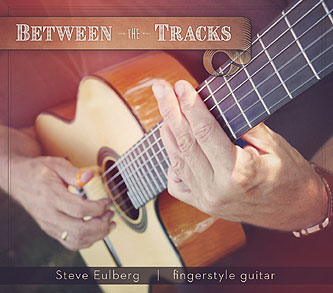 Based
in San Mateo, California, acoustic guitarist Steve Eulberg released
his ninth solo recording in August 2019. The 13-track, 44 minute CD,
called Between The Tracks is a fine offering of relaxing,
modern solo guitar magic that serves up a wide range of jazzy and
bluesy acoustic instrumentals. On the inside of the tastefully packaged
digi-pak artwork you can see a picture of Steve with his nylon string
guitar. Guitars featured on Between The Tracks include a Huss
& Dalton DS and a Cordoba Fusion 14 Maple. Steve’s track
by track anecdotes are accompanied by his detailed liner notes, which
describe early guitar influences such as Mason Williams, well known
jazzy, guitar-centric artists including Earl Klugh and Antonio Carlos
Jobim, as well as finger-style, guitar-centric pop artists like John
Denver and Jim Croce. In his notes, Steve cites the late great Pete
Huttlinger, Tommy Emmanuel, Phil Keaggy, ragtime steel guitar ace
Rev. Gary Davis and Leo Kottke. There’s also a classical influence
and Steve cites reflective music from classical composer Debussy,
while the lone cover here is “Guitar Etude No.3”, an instrumental
track written by pop singer Dan Fogelberg. You can hear just about
every type of solo guitar style, from folk and blues to jazz and even
ragtime on Steve Eulberg’s superbly recorded 2019 solo album
Between The Tracks. www.SteveEulberg.com
Based
in San Mateo, California, acoustic guitarist Steve Eulberg released
his ninth solo recording in August 2019. The 13-track, 44 minute CD,
called Between The Tracks is a fine offering of relaxing,
modern solo guitar magic that serves up a wide range of jazzy and
bluesy acoustic instrumentals. On the inside of the tastefully packaged
digi-pak artwork you can see a picture of Steve with his nylon string
guitar. Guitars featured on Between The Tracks include a Huss
& Dalton DS and a Cordoba Fusion 14 Maple. Steve’s track
by track anecdotes are accompanied by his detailed liner notes, which
describe early guitar influences such as Mason Williams, well known
jazzy, guitar-centric artists including Earl Klugh and Antonio Carlos
Jobim, as well as finger-style, guitar-centric pop artists like John
Denver and Jim Croce. In his notes, Steve cites the late great Pete
Huttlinger, Tommy Emmanuel, Phil Keaggy, ragtime steel guitar ace
Rev. Gary Davis and Leo Kottke. There’s also a classical influence
and Steve cites reflective music from classical composer Debussy,
while the lone cover here is “Guitar Etude No.3”, an instrumental
track written by pop singer Dan Fogelberg. You can hear just about
every type of solo guitar style, from folk and blues to jazz and even
ragtime on Steve Eulberg’s superbly recorded 2019 solo album
Between The Tracks. www.SteveEulberg.com
mwe3.com presents an interview with
Steve Eulberg
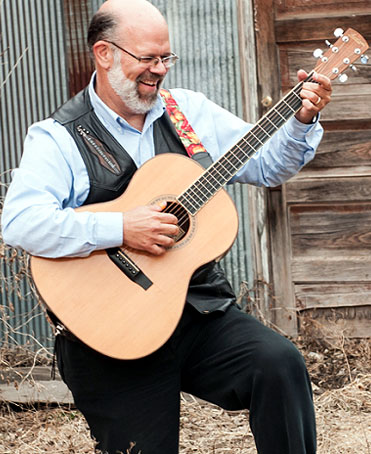 mwe3:
Can you tell us where you’re from originally and something about
where you live now? Have you traveled to many states in the US and
other countries?
mwe3:
Can you tell us where you’re from originally and something about
where you live now? Have you traveled to many states in the US and
other countries?
Steve Eulberg: I was born and raised in Pemberville, NW Ohio
in Wood County. I live in San Mateo, California in the San Francisco
Bay Area. I have toured and performed across the USA including Hawaii
and Alaska, Canada, Mexico, England, Scotland and Germany. Being 20
minutes from the ocean and 20 minutes from San Francisco Bay means
that beach, and seaside and marine air are a huge part of our lives.
The Mediterranean climate with wet & dry seasons has been adjustment,
after living in the four-season states Colorado, Missouri, Wisconsin
and Ohio... but it is one we are happy to make!
mwe3: Tell us about your early interest in the dulcimer and
your mom’s ukulele. What was growing up like and did your mom
get you interested in the dulcimer? On top of that, the Hughes Dulcimer
Company was in your own town, yet you say you couldn’t afford
one so you built your own. So how did you move from Ukulele and dulcimer
to the steel and nylon string acoustic guitars?
Steve Eulberg: When I was bitten by the guitar ‘bug’
it was right after Jim Croce and Maury Muehleisen's plane crashed.
The only instrument we had in the house with strings and a neck was
my mom’s ukulele, which she had decided to start playing again.
We ended up with a “hot seat” in the dining room and that
ukulele didn’t stay quiet very long between the two of us!
I first heard both kinds of dulcimer while in college in central Ohio
at Capital University. Both were played by touring musicians and since
I was already playing guitar and mandolin, I was intrigued. The family
of my duo partner, on banjo, built and gifted him with a mountain
dulcimer for Christmas one year. I was determined to work it into
our act but couldn’t figure it out. I asked him how to play it.
He said, “You can’t. It isn’t like regular music.”
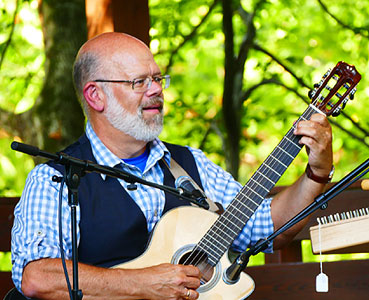 I saved
up and built a FolkRoots mountain dulcimer kit, which was not only
affordable, but at that time, in 1980, probably the only way to find
a dulcimer in a music store in Central Ohio! Then I moved it with
me around the country trying to figure out how to play it. Rural Michigan
and Chicago provided few clues, but it was in the Mile High City of
Denver when I say, “The scales fell from my eyes into my fingers”
and I began to play music - the songs & tunes I already knew.
The Hughes Dulcimer Company, purveyor of many different musical instrument
kits, was down the street from my west Denver apartment.
I saved
up and built a FolkRoots mountain dulcimer kit, which was not only
affordable, but at that time, in 1980, probably the only way to find
a dulcimer in a music store in Central Ohio! Then I moved it with
me around the country trying to figure out how to play it. Rural Michigan
and Chicago provided few clues, but it was in the Mile High City of
Denver when I say, “The scales fell from my eyes into my fingers”
and I began to play music - the songs & tunes I already knew.
The Hughes Dulcimer Company, purveyor of many different musical instrument
kits, was down the street from my west Denver apartment.
After being transfixed by the sound of the hammered dulcimer the first
time I heard it in college when I found that the Hughes Company had
kits I began visiting every one of my days off from my work and began
saving up my shekels to buy one for my birthday in February. I built
it and played for an event at church the next week… I won’t
say I played well, but I was in such a sensitive period that all I
could do WAS play it!
mwe3: What pop and jazz artists got you interested contemporary
music and traditional folk music? I ask because your bio says you
were influenced by Tchaikovsky and Stevie Wonder as well as Jim Croce.
That’s a pretty diverse musical background!
Steve Eulberg: I remember watching The Beatles on the Ed Sullivan
show… but couldn’t hear much because of the screaming teenaged
girls! But they were just a part of the musical presence in my life.
Music was what we did at home, in the car and at church. We didn’t
listen to the radio, but mom played the piano and we sang. When I
grew older, we lived in the radio range of CKLW, the Motor City station
that broadcast from Windsor, Canada across the river from Detroit,
Michigan… so MOTOWN was big on the radio, along with other pop
music.
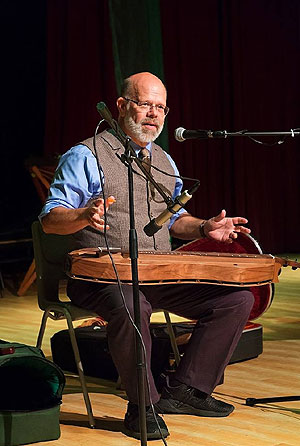 When
FM radio began to get bigger I gravitated to that… “Wildfire”
by Michael Martin Murphy was on constant rotation. I watched Don Kirschner’s
Rock Concert and the Midnight Special on weekend television. Pete
Seeger, Elton John, Jim Croce, John Denver, Leadbelly, Three Dog Night,
Blood Sweat & Tears, Doc Severinson, Bread, James Taylor, Neil
Diamond, Linda Ronstadt… along with Phil Keaggy and John Michael
Talbot, Carole King, Carly Simon, England Dan & John Ford Coley,
Seals & Crofts and Dan Fogelberg played the music of my teenaged
soundtrack.
When
FM radio began to get bigger I gravitated to that… “Wildfire”
by Michael Martin Murphy was on constant rotation. I watched Don Kirschner’s
Rock Concert and the Midnight Special on weekend television. Pete
Seeger, Elton John, Jim Croce, John Denver, Leadbelly, Three Dog Night,
Blood Sweat & Tears, Doc Severinson, Bread, James Taylor, Neil
Diamond, Linda Ronstadt… along with Phil Keaggy and John Michael
Talbot, Carole King, Carly Simon, England Dan & John Ford Coley,
Seals & Crofts and Dan Fogelberg played the music of my teenaged
soundtrack.
I always leaned toward the instruments I played: piano, trumpet, acoustic
guitar... much more than the growing electric influences that were
taking over. I also dreamed more of intimate venues rather a than
stadium or arena setting. The harmonies of America, The Eagles and
more had me singing along.
I was active playing trumpet in school bands, including the “Stage
Band” which was a Big Band, which played for school dances and
concerts. With them, I played in the outside venue of the Lincoln
Center in New York for a jazz festival one summer.
mwe3: You also play piano and bass too? Did interest in dulcimer
and ukulele inspire you to learn other instruments? Do you recall
your first guitar and was it nylon or steel string? Nylon is easier
on the finger tips but the neck makes the technique more challenging
right?
Steve Eulberg: For me the progression was: Voice, piano, trumpet,
harmonica, guitar, mandolin, mountain dulcimer, hammered dulcimer,
banjo, bass, autoharp and more.
You bet I remember my guitars! My first guitar was a nylon-string
classical guitar that was a Christmas gift. Since what I wanted was
a steel-string acoustic, I took off those nylon strings as soon as
the holiday was over and put on steel strings. After a very short
time the bridge started peeling off the soundboard and I was embarrassed
at the music store when they told me that what I had done was breaking
my guitar. I went back and replaced the nylon strings; the bridge
relaxed and I began saving for a bolted-on neck Epiphone 6-string
that I played for 25 years, before that neck imploded.
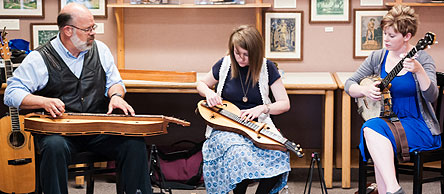 Then
I played a used Takamine for a time, my son now has that one until
I began my quest to find an instrument I could truly love. I found
it on the very first night of my quest in September… but in true
Galahad tradition, I had to continue my quest until I convinced myself.
Then
I played a used Takamine for a time, my son now has that one until
I began my quest to find an instrument I could truly love. I found
it on the very first night of my quest in September… but in true
Galahad tradition, I had to continue my quest until I convinced myself.
My Huss & Dalton, DS, slope-shouldered, modeled after the 1930s-40s
Gibsons, but with radiused top, neck and extra large soundhole, is
the one that grabbed my ear and heart and still has them.
Yes, there is different technique and some adjustments to make. The
nylon strings can feel like walking on the driveway with water hoses
under your feet compared to the thin, tighter steel that bites your
fingers at first! The typical nylon-string guitar has a much wider
neck as well, so a bit of finger stretching is required.
mwe3: Why did you call your 2019 album Between The Tracks
and how would you compare it with your other album releases? Being
an all-instrumental album, what did you set out to achieve on the
Between The Tracks album?
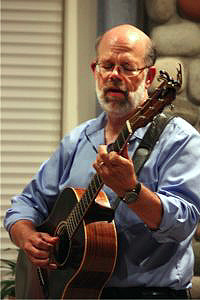 Steve
Eulberg: I grew up in a town that was bounded on east and west
by the Baltimore and Ohio and the Chesapeake and the Ohio Railroads
so the rhythms of the trains and their whistles played a large part
in the landscape of my childhood.
Steve
Eulberg: I grew up in a town that was bounded on east and west
by the Baltimore and Ohio and the Chesapeake and the Ohio Railroads
so the rhythms of the trains and their whistles played a large part
in the landscape of my childhood.
This instrumental release is actually a return to some of my earlier
focus. In 1999 I released my first all-instrumental album of mountain
dulcimer ensembles entitled, Hark! the Glad Sound and followed
that with ‘Twas in the Moon of Wintertime, an album of
mountain and hammered dulcimer instrumentals, in 2003.
Most of my other recordings have been songs, or combinations of songs
and filled with lyrics to convey the messages and themes together
with instrumental interludes.
This time I really wrestled with what I could say, in this current
world of noise and confusion, misinformation and clamor, and I realized
that the thing that helped me navigate these waters was wordless music.
Playing and composing these tunes helped me calm the voices in my
own head and put my fears and anxieties back into their regular-sized
beds to rest.
mwe3:
How many albums have you recorded and released and are they all instrumental
releases? I did hear your track “I Miss America” which is
a vocal track. It’s interesting to hear that side of your music
too.
Steve Eulberg: Between the Tracks is my 9th solo recording,
but I have recorded two with my duo Fiddle Whamdiddle, an EP with
my trio S-E-A-Folkgrass, and several with friends. I have 16 recordings,
plus several singles, cassettes and 2 DVDs to my credit. In addition,
I’ve been honored to be included in 3 national compilations of
mountain dulcimer players and have composed for theatrical settings.
Thank you for mentioning “I Miss America”. That tune and
“War Is Sweet” were written in the early months of this
millennium and ended up being included in Neil Young’s “Living
With War” webpage. “War Is Sweet” also topped the Independent
Country Song chart in New York in September 2007. It is unfortunate
that “I Said Nothing,” a vocal setting of Martin Niemöller’s
famous quote continues to apply over a decade after I wrote it. One
of the highlights of my career was being able to sing that in the
church he served in Dahlem-Dorf, Berlin, Germany in 2006.
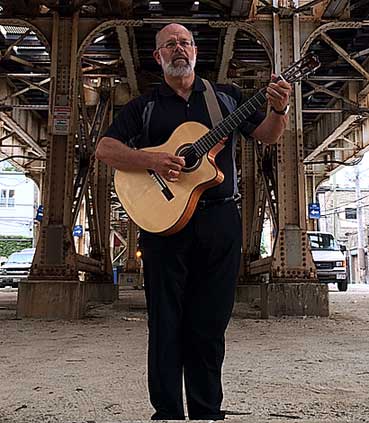 mwe3:
Between The Tracks starts off with “Habits” and it’s
a kind of bossa nova inspired track. I read that you were influenced
by Jobim’s music too and I was then thinking a lot of your new
album has that laid-back bossa style.
mwe3:
Between The Tracks starts off with “Habits” and it’s
a kind of bossa nova inspired track. I read that you were influenced
by Jobim’s music too and I was then thinking a lot of your new
album has that laid-back bossa style.
Steve Eulberg: “The Girl From Ipanema” continues
to define a summer feel for me, now these many years after Jobim brought
bossa nova style to the US. I love the tension between the rich, colorful
chords and the smooth rhythms that make one lean back and sway. Once
I got in that zone, I began to find more and more musical ideas that
have been fun to explore and develop.
mwe3: Speaking of bossa nova style guitar instrumentals, track
12 “Guitar Etude No. 3” was composed by Dan Fogelberg, who
is best remembered as a folk-singer. How did you find that track as
it’s the only cover song on the new album?
Steve Eulberg: Dan’s father was a composer and conductor,
so instrumental music was rich in his background. I think fewer people
are aware of his instrumental recordings because of the pop radio
system, which is tilted toward lyric-based music. His two albums with
Tim Weisberg gave him room to expand and explore... and, thankfully,
garner radio play which allowed hearers like me to be both transfixed
and inspired by them!
“Guitar Etude No. 3” was recorded by Fogelberg with Weisberg
on his Twin Sons of Different Mothers LP as a guitar-flute
duet and I have been taken with it since first hearing it. I never
envisioned how to play it as a solo. I recently heard a live recording
of Dan playing it in Carnegie Hall where he sang the flute parts.
Not long after I saw a competition video of someone who had worked
it out as a guitar solo and I resolved to do the same. It is a delightful
and challenging piece to learn and play. I am very pleased with the
result.
mwe3: Can you tell us something about the way Between The
Tracks was recorded? Was it all recorded live and then the percussion
tracks were laid down? What tracks were recorded first?
Steve Eulberg: I recorded the guitars live in the studio with
Grammy-winning engineer, Oscar Autie, in his El Cerrito studio in
the East Bay. Often artists will begin with the percussion and then
layer the other instruments. For this solo project, I began with the
guitar tracks first, adding percussion later. Because I had been working
on these compositions for such an extended period of time, we were
able to record and mix them very efficiently, in a short period of
time in March of this year.
mwe3: In addition to the bossa nova tracks, the Ragtime guitar
sound is very much in evidence on Between The Tracks. What
ragtime guitarists influenced you most? I still have my book “The
Art of Ragtime Guitar” which I bought way back in 1974. Have
you seen that book?
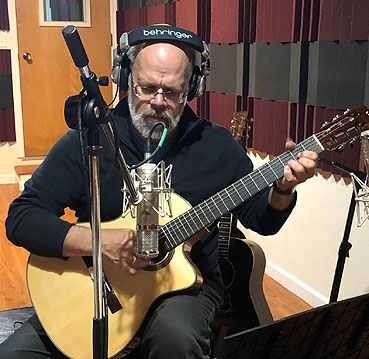 Steve
Eulberg: I am not aware of that particular book/disc, but I still
have several of that type of resources still in my library! Leo Kottke,
Doc Watson, Elizabeth Cotten are some of the players who paved my
path.
Steve
Eulberg: I am not aware of that particular book/disc, but I still
have several of that type of resources still in my library! Leo Kottke,
Doc Watson, Elizabeth Cotten are some of the players who paved my
path.
mwe3: Tell us about the guitars you feature on Between The
Tracks including your Cordoba classical and your Huss & Dalton
DS guitar. What do you like best about those guitars and what other
guitars do you have in your collection? What strings to you use with
those two guitars?
Steve Eulberg: I prefer John Pearse Phosphor Bronze Wound Light
Gauge (Set #600L) for my Huss & Dalton, and D’Addario Pro-Arté
Nylon Core Silver Wound nylon (Set EJ45) for my Cordoba.
What I loved from the moment I held and strummed both of these guitars
is the tone that floats from them. The Huss & Dalton sounded like
a concert hall in my lap with such a balanced and mature tone; the
Cordoba just vibrated through my chest with such warmth of round tone.
I am also sort of particular about the feel of the neck in my hand.
I don’t have long fingers, so generally I feel more comfortable
with thinner necks, but I also notice that the I prefer a gloss finish
on the back of the neck rather than a matte finish.
For a long time played a Samick half-sized body nylon-string classical
guitar because it had an on-board pickup and I liked the round tone,
but when I recently found my Cordoba Fusion 14 cutaway classical guitar...
I decided that I had additional room in my heart for more guitar love!
My 1970s-era Guild 12-String has a long-story of its own that I can
tell you sometime.
mwe3: “Godspeed” is for the late great Pete Huttlinger.
His passing was a loss for the guitar community. What influence did
Pete give you as a musician? I remember Pete’s great instrumental
Stevie Wonder tribute album from 2009 called Finger Picking Wonder.
Steve Eulberg: I always loved Pete’s lyrical arrangements
and his warm and generous spirit. The first time I performed on stage
at the Walnut Valley Festival he complimented my set as he was setting
up to follow me. Those kindnesses really matter. I followed his career
and health challenges and was so glad he returned to performing, and
then felt devastated at his loss. “Godspeed” was my only
way to respond. I composed and captured the first draft of that tune
in one take.
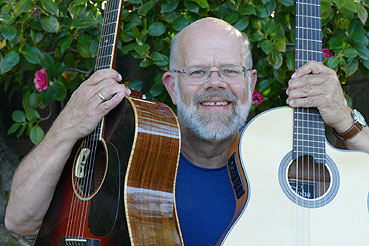 mwe3:
What other artists do you work with and record with? In addition to
your recording career, you also produce and teach music as well as
perform live concerts. What artists are you currently working with
both as a performer and producer?
mwe3:
What other artists do you work with and record with? In addition to
your recording career, you also produce and teach music as well as
perform live concerts. What artists are you currently working with
both as a performer and producer?
Steve Eulberg: I work with Colorado fiddler Vi Wickam in our
duo Fiddle Whamdiddle, and with my other duo partner Erin Mae Lewis,
a National Champion Mountain Dulcimer player, from Wichita, Kansas.
She and I have also performed with her fiddle and banjo playing sister,
Amber Rogers Clark as a trio: S-E-A-Folkgrass.
I enjoy playing informally with many musicians in the Bay Area, and
especially with dulcimer players across the country. I am currently
working as transcriber and typesetter for Deborah Hamouris and Lisa
Sniderman (“Aeode”) from the Bay Area. I conduct the Berkeley
Dulcimer Orchestra, which performs classical and popular multipart
arrangements from my Dulcimer Orchestra Library Project.
mwe3: Have you recorded Dulcimer-based albums? What dulcimer
players do you like and what dulcimer albums have you released?
Steve Eulberg: Dulcimers have been my niche for many years.
Next year I will celebrate my 40 Dulcimer-filled years with my touring
and performing. In 2010, a fan sponsored a concert in a nice venue
for my 30 Dulcimer-Filled Years, which I had filmed and edited into
my DVD, Steve Eulberg in Concert. I am planning a project with
my daughter, Kaitlin, who is also a mountain dulcimer player and singer.
mwe3: What about your upcoming live shows and what music will
you be featuring on the shows? Have you played in many states and
have you done any shows overseas?
Steve Eulberg: I will be at the Pickin’ Porch in Townsend,
Tennessee (Aug 31); Folkcraft Music in Indiana (9/14) for a day of
workshops and concert; then I will play in some different settings
in our local hospital and for my church. I will be featuring a sort
of “greatest hits” from my career, together with the tunes
on Between the Tracks. It is easier to count the states in
which I have not yet performed: Montana, North Dakota, Maine, Massachusetts
and South Carolina.
 mwe3:
What other plans do you have upcoming for the rest of 2019? Should
be an interesting year for all of us coming up.
mwe3:
What other plans do you have upcoming for the rest of 2019? Should
be an interesting year for all of us coming up.
Steve Eulberg: I have taught guitar on JamPlay.com since 2006
and co-own DulcimerCrossing.com to teach dulcimers on-line, so I have
several lessons to edit and more to recruit and record for those students.
I have an Artist-in-Residency retreat planned for December in Alaska
and then I have several festival bookings for next year to help me
celebrate my 40 Dulcimer-Filled Years. I have several different recording
projects that are lining up in my queue and now that this one is released,
some new compositions are starting to flow out. I am grateful for
my patrons on Patreon
whose ongoing support pushes me to focus on creativity, and who also
get the first access to everything I do.



